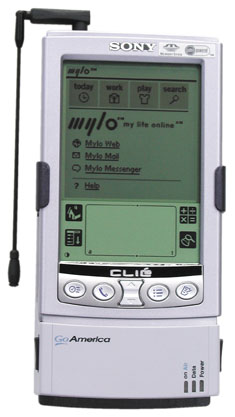CLIE S320 with MYLO wireless sled
Sony takes its monochrome units wireless

by Shawn Barnett
November, 2001, Issue 42
First I should say that the Sony CLIE S320 is a beautiful little Palm OS device with a screen and backlight that are absolutely stunning. The screen, despite its smaller size, outclasses the m500 easily, especially when the backlight becomes necessary. A real backlight is unbeatable in the handheld world, and the S320 has one. My only minor complaint about the S320 is the relative difficulty of pressing the front scroll buttons, but that's not a huge issue. It also comes with a new rubbery flip lid that gives access to the Memory Stick when open, yet helps hold it in place when closed. If you're more into data than music and pictures, the S320 is a perfect fit for an amazing US$199.
And if you are indeed a data nut, you'll be pleased to know that the S320 is the first to work with Sony's new MYLO wireless sled and service. MYLO stands for MY Life Online. It requires two additional components: the MYLO GoAmerica sled and a Sierra Wireless AirCard 300, both of which are available from Sony for US$299, with a US$100 mail-in rebate.
Software installation is a snap, just run the CD and HotSync the programs over. You also need to charge the battery in the sled before you use it, which takes an hour or so. The good news is that you can charge both the sled and the CLIE at the same time. Even better, you can place the whole assembly into the Stowaway Keyboard and type while you're online, due to the complete HotSync pass-through port built into the sled.
The MYLO service itself is a simple front end to a fairly ambitious wireless service. It's similar to the model OmniSky employs, where very little data is stored on the device itself; data is instead downloaded when needed. On the first Palm VII, by contrast, you had to HotSync an application for each service you intended to access, before you hit the road. Later, Palm offered a portal similar to this one, with many PQAs bundled in one interface. But MYLO has its own personality, with a simple, attractively minimalist interface.
On the front page you can immediately go to one of the four major areas, titled Today, Work, Play, and Search. Today takes you to a page much like a personal home page, where all your favorite stuff is quickly accessible: email, headlines, stock quotes, weather; and you can format this page however you like. The Work page gives you access to a few basic portals, including weather lookup, news, travel services, and business services, such as online faxing.
Play has many portals for entertainment, including where to dine and shop, what's new in music and movies, sports scores, and even a few games. Search offers the powerful Google search engine, and allows browsing of most web pages, though usually without graphics.
The email application is perhaps the most impressive of the features I've used. All I had to do was put in my basic email access information and in only a few seconds MYLO had my email headers downloaded and ready. From there, I just tapped on the headers I was interested in and in only a few seconds more that email was retrieved. Of all the services, this one had the lowest lag time; over all the wireless email services and applications I've used, this is the fastest I've seen, hands down.
As for the rest of the MYLO's service speed, it was little different from any other. Usually about as fast as a Novatel Minstrel modem or a Palm VIIx, which can mean from five seconds to a full minute for some types of data to come down. It depends on how busy the network is, how busy the Internet is, and finally how busy the server you're trying to access is. But as I say, this performance lag time is common to all such CDPD services. I really like that there are status bars to tell you where in the process you are every step of the way. There's also always a prominent signal strength indicator onscreen to tell you whether you've got coverage.
Of all the other CDPD units I've used, this one also has the longest battery life. Under normal usage, the battery in the sled should last about as long as the battery in the CLIE. That could go out to a week or so. The 1350 mAh battery might have something to to with that. All I know is I kept expecting it to expire as have others I've used, and it just kept going.
Compared to the size of the S320 itself, the combination is a little big. But on the whole, it's pretty narrow, so it still fits in the hand well. The Sierra Wireless Air Card's antenna moves just about every which way, so you can position it however is comfortable.
The MYLO service is not only for CLIEs, though. Because you're using a Sierra Wireless PC Card, you can make it do double duty. Just remove it from the sled and slide it into any notebook PC Card slot and suddenly you're wirelessly online with your PC as well. It's only 19.2 bps, which isn't fast for modern web pages, but it's access all the same. Pricing for this is different, however. For just the CLIE, pricing is US$39.95 a month. For just the PC, pricing is US$59.95 a month. If you want both services, it's US$79.95 a month, again with the US$100 rebate off the US$299 for the card and sled.
For the CLIE user needing fast access to email and basic Web access on the go, it's a great service.
-Shawn Barnett
Questions? Comments?
Back to Palm Section

